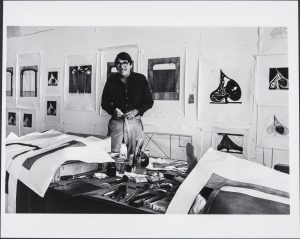Artsy: Tasked with Creating a Catalogue Raisonné, These Art Historians Become Detectives
October 6, 2016
By Abigail Cain

Twenty-five-year-old Robert Motherwell arrived in Manhattan in 1940, an erudite West Coast transplant who planned to study art history at Columbia University. Collector Peggy Guggenheim soon discovered the aspiring artist and, sensing promise, commanded him to make a collage for a survey at her New York gallery. This early experimentation with the medium sparked years of fruitful collage-making that served as a prequel of sorts to Motherwell’s later Abstract Expressionist paintings. One such collage, titled Figure, was completed in 1945 and sold the following year. From that point on, the work vanished from the public eye. During the next half-century, it never went up for auction or appeared on loan in a museum; it wasn’t offered for sale by a dealer or gallery.
So, when Katy Rogers began to hunt down Figure in the early 2000s, the trail had gone cold. As a researcher for Motherwell’s catalogue raisonné project, she was part of a team tasked with finding every painting and collage that the noted Abstract Expressionist had made during his lifetime. And in this case, all Rogers had to go on was one black-and-white archival photograph of Figure and the name of the man who had purchased it back in 1946. She scoured the internet for signs of the buyer, only to discover that he had passed away years earlier. His obituary listed the names of his children, so Rogers tracked them down, too, and sent letters asking about the work. Yes, they eventually replied, we know where the collage is. After some 60-odd years, it was still hanging on their mother’s wall—only now she resided in an assisted living facility on the West Coast. Rogers sent someone out to take a new photograph of the rediscovered work (this time, in color) to be printed in the catalogue raisonné. Case closed.